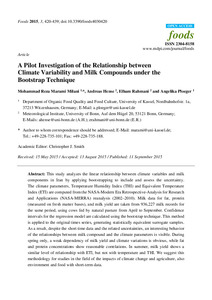Aufsatz
Artikel (Publikationen im Open Access gefördert durch die UB)

A pilot investigation of the relationship between climate variability and milk compounds under the bootstrap technique
Zusammenfassung
This study analyzes the linear relationship between climate variables and milk components in Iran by applying bootstrapping to include and assess the uncertainty. The climate parameters, Temperature Humidity Index (THI) and Equivalent Temperature Index (ETI) are computed from the NASA-Modern Era Retrospective-Analysis for Research and Applications (NASA-MERRA) reanalysis (2002–2010). Milk data for fat, protein (measured on fresh matter bases), and milk yield are taken from 936,227 milk records for the same period, using cows fed by natural pasture from April to September. Confidence intervals for the regression model are calculated using the bootstrap technique. This method is applied to the original times series, generating statistically equivalent surrogate samples. As a result, despite the short time data and the related uncertainties, an interesting behavior of the relationships between milk compound and the climate parameters is visible. During spring only, a weak dependency of milk yield and climate variations is obvious, while fat and protein concentrations show reasonable correlations. In summer, milk yield shows a similar level of relationship with ETI, but not with temperature and THI. We suggest this methodology for studies in the field of the impacts of climate change and agriculture, also environment and food with short-term data.
Zitierform
In: Foods. - Basel : MDPI, 2015, 4 (3), 420-439Förderhinweis
Gefördert durch den Publikationsfonds der Universität KasselSammlung(en)
Publikationen (Fachgebiet Ökologische Lebensmittelqualität und Ernährungskultur)Artikel (Publikationen im Open Access gefördert durch die UB)
Zitieren
@article{urn:nbn:de:hebis:34-2016011949697,
author={Marami Milani, Mohammad Reza and Hense, Andreas and Rahmani, Elham and Ploeger, Angelika},
title={A pilot investigation of the relationship between climate variability and milk compounds under the bootstrap technique},
year={2015}
}
0500 Oax 0501 Text $btxt$2rdacontent 0502 Computermedien $bc$2rdacarrier 1100 2015$n2015 1500 1/eng 2050 ##0##urn:nbn:de:hebis:34-2016011949697 3000 Marami Milani, Mohammad Reza 3010 Hense, Andreas 3010 Rahmani, Elham 3010 Ploeger, Angelika 4000 A pilot investigation of the relationship between climate variability and milk compounds under the bootstrap technique / Marami Milani, Mohammad Reza 4030 4060 Online-Ressource 4085 ##0##=u http://nbn-resolving.de/urn:nbn:de:hebis:34-2016011949697=x R 4204 \$dAufsatz 4170 7136 ##0##urn:nbn:de:hebis:34-2016011949697
<resource xsi:schemaLocation="http://datacite.org/schema/kernel-2.2 http://schema.datacite.org/meta/kernel-2.2/metadata.xsd"> 2016-01-19T08:07:19Z 2016-01-19T08:07:19Z 2015 2304-8158 urn:nbn:de:hebis:34-2016011949697 http://hdl.handle.net/123456789/2016011949697 Gefördert durch den Publikationsfonds der Universität Kassel eng Urheberrechtlich geschützt https://rightsstatements.org/page/InC/1.0/ 630 A pilot investigation of the relationship between climate variability and milk compounds under the bootstrap technique Aufsatz This study analyzes the linear relationship between climate variables and milk components in Iran by applying bootstrapping to include and assess the uncertainty. The climate parameters, Temperature Humidity Index (THI) and Equivalent Temperature Index (ETI) are computed from the NASA-Modern Era Retrospective-Analysis for Research and Applications (NASA-MERRA) reanalysis (2002–2010). Milk data for fat, protein (measured on fresh matter bases), and milk yield are taken from 936,227 milk records for the same period, using cows fed by natural pasture from April to September. Confidence intervals for the regression model are calculated using the bootstrap technique. This method is applied to the original times series, generating statistically equivalent surrogate samples. As a result, despite the short time data and the related uncertainties, an interesting behavior of the relationships between milk compound and the climate parameters is visible. During spring only, a weak dependency of milk yield and climate variations is obvious, while fat and protein concentrations show reasonable correlations. In summer, milk yield shows a similar level of relationship with ETI, but not with temperature and THI. We suggest this methodology for studies in the field of the impacts of climate change and agriculture, also environment and food with short-term data. open access In: Foods. - Basel : MDPI, 2015, 4 (3), 420-439 Marami Milani, Mohammad Reza Hense, Andreas Rahmani, Elham Ploeger, Angelika doi:10.3390/foods4030420 </resource>
Die folgenden Lizenzbestimmungen sind mit dieser Ressource verbunden:
Urheberrechtlich geschützt

